Response of Natural Vegetation to Climate in Dryland Ecosystems: A Comparative Study between Xinjiang and Arizona
Abstract
1. Introduction
2. Methods and Data Sources
2.1. Study Areas
2.2. Land Cover Datasets
2.3. Long-Term Aridity Index
2.4. Quasi-8-Day Precipitation and Air Temperature
2.5. Quasi-8-Day Vegetation Index
3. Results and Discussion
3.1. Unchanged Land Cover Types and Aridity
3.2. Climate Change and Variability
3.3. Vegetation Change and Variability
3.4. Response of Vegetation to Climate in Study Areas
3.5. Response of Vegetation to Climate in Typical Subregions
4. Concluding Remarks
Author Contributions
Funding
Acknowledgments
Conflicts of Interest
References
- Middleton, N.J.; Sternberg, T. Climate hazards in drylands: A review. Earth Sci. Rev. 2013, 126, 48–57. [Google Scholar] [CrossRef]
- Cherlet, M.; Hutchinson, C.; Reynolds, J.; Hill, J.; Sommer, S.; von Maltitz, G. World Atlas of Desertification, 3rd ed.; Publication Office of the European Union: Luxembourg, 2018. [Google Scholar]
- Huang, J.; Li, Y.; Fu, C.; Chen, F.; Fu, Q.; Dai, A.; Shinoda, M.; Ma, Z.; Guo, W.; Li, Z.; et al. Dryland climate change: Recent progress and challenges. Rev. Geophys. 2017, 55, 719–778. [Google Scholar] [CrossRef]
- Wang, L.; D’Odorico, P.; Evans, J.P.; Eldridge, D.J.; McCabe, M.F.; Caylor, K.K.; King, E.G. Dryland ecohydrology and climate change: Critical issues and technical advances. Hydrol. Earth Syst. Sci. 2012, 16, 2585–2603. [Google Scholar] [CrossRef]
- Ahlström, A.; Raupach, M.R.; Schurgers, G.; Smith, B.; Arneth, A.; Jung, M.; Reichstein, M.; Canadell, J.G.; Friedlingstein, P.; Jain, A.K.; et al. The dominant role of semi-arid ecosystems in the trend and variability of the land CO2 sink. Science 2015, 348, 895–899. [Google Scholar] [CrossRef]
- Vinoj, V.; Rasch, P.J.; Wang, H.; Yoon, J.-H.; Ma, P.-L.; Landu, K.; Singh, B. Short-term modulation of Indian summer monsoon rainfall by West Asian dust. Nat. Geosci. 2014, 7, 308–313. [Google Scholar] [CrossRef]
- Ward, D. The Biology of Deserts; Oxford University Press: New York, NY, USA, 2009. [Google Scholar]
- Reynolds, J.F.; Smith, D.M.S.; Lambin, E.F.; Turner, B.L.; Mortimore, M.; Batterbury, S.P.J.; Downing, T.E.; Dowlatabadi, H.; Fernández, R.J.; Herrick, J.E.; et al. Global desertification: Building a science for dryland development. Science 2007, 316, 847–851. [Google Scholar] [CrossRef]
- Huang, J.; Yu, H.; Guan, X.; Wang, G.; Guo, R. Accelerated dryland expansion under climate change. Nat. Clim. Chang. 2016, 6, 166–171. [Google Scholar] [CrossRef]
- Huang, J.; Ji, M.; Xie, Y.; Wang, S.; He, Y.; Ran, J. Global semi-arid climate change over last 60 years. Clim. Dyn. 2016, 46, 1131–1150. [Google Scholar] [CrossRef]
- Zhao, T.; Dai, A. The magnitude and causes of global drought changes in the twenty-first century under a low–moderate emissions scenario. J. Clim. 2015, 28, 4490–4512. [Google Scholar] [CrossRef]
- Piao, S.; Yin, G.; Tan, J.; Cheng, L.; Huang, M.; Li, Y.; Liu, R.; Mao, J.; Myneni, R.B.; Peng, S.; et al. Detection and attribution of vegetation greening trend in China over the last 30 years. Glob. Chang. Biol. 2015, 21, 1601–1609. [Google Scholar] [CrossRef]
- Zhao, J.; Zhang, H.; Zhang, Z.; Guo, X.; Li, X.; Chen, C. Spatial and temporal changes in vegetation phenology at middle and high latitudes of the Northern Hemisphere over the past three decades. Remote Sens. 2015, 7, 10973–10995. [Google Scholar] [CrossRef]
- Wang, X.; Piao, S.; Ciais, P.; Li, J.; Friedlingstein, P.; Koven, C.; Chen, A. Spring temperature change and its implication in the change of vegetation growth in North America from 1982 to 2006. Proc. Natl. Acad. Sci. USA 2011, 108, 1240–1245. [Google Scholar] [CrossRef]
- Zhao, X.; Tan, K.; Zhao, S.; Fang, J. Changing climate affects vegetation growth in the arid region of the northwestern China. J. Arid Environ. 2011, 75, 946–952. [Google Scholar] [CrossRef]
- Sjöström, M.; Ardö, J.; Arneth, A.; Boulain, N.; Cappelaere, B.; Eklundh, L.; de Grandcourt, A.; Kutsch, W.L.; Merbold, L.; Nouvellon, Y.; et al. Exploring the potential of MODIS EVI for modeling gross primary production across African ecosystems. Remote Sens. Environ. 2011, 115, 1081–1089. [Google Scholar] [CrossRef]
- Tian, F.; Brandt, M.; Liu, Y.Y.; Verger, A.; Tagesson, T.; Diouf, A.A.; Rasmussen, K.; Mbow, C.; Wang, Y.; Fensholt, R. Remote sensing of vegetation dynamics in drylands: Evaluating vegetation optical depth (VOD) using AVHRR NDVI and in situ green biomass data over West African Sahel. Remote Sens. Environ. 2016, 177, 265–276. [Google Scholar] [CrossRef]
- Yang, J.; Weisberg, P.J.; Bristow, N.A. Landsat remote sensing approaches for monitoring long-term tree cover dynamics in semi-arid woodlands: Comparison of vegetation indices and spectral mixture analysis. Remote Sens. Environ. 2012, 119, 62–71. [Google Scholar] [CrossRef]
- Chen, J.; Yan, F.; Lu, Q. Spatiotemporal variation of vegetation on the Qinghai–Tibet Plateau and the influence of climatic factors and human activities on vegetation trend (2000–2019). Remote Sens. 2020, 12, 3150. [Google Scholar] [CrossRef]
- Fan, Z.; Li, S.; Fang, H. Explicitly identifying the desertification change in CMREC area based on multisource remote data. Remote Sens. 2020, 12, 3170. [Google Scholar] [CrossRef]
- Misra, G.; Cawkwell, F.; Wingler, A. Status of phenological research using Sentinel-2 data: A review. Remote Sens. 2020, 12, 2760. [Google Scholar] [CrossRef]
- Anderson, G.L.; Hanson, J.D.; Haas, R.H. Evaluating landsat thematic mapper derived vegetation indices for estimating above-ground biomass on semiarid rangelands. Remote Sens. Environ. 1993, 45, 165–175. [Google Scholar] [CrossRef]
- Gamon, J.A.; Field, C.B.; Goulden, M.L.; Griffin, K.L.; Hartley, A.E.; Joel, G.; Penuelas, J.; Valentini, R. Relationships between NDVI, canopy structure, and photosynthesis in three Californian vegetation types. Ecol. Appl. 1995, 5, 28–41. [Google Scholar] [CrossRef]
- Wessels, K.J.; Prince, S.D.; Zambatis, N.; MacFadyen, S.; Frost, P.E.; Zyl, D.V. Relationship between herbaceous biomass and 1-km2 Advanced Very High Resolution Radiometer (AVHRR) NDVI in Kruger National Park, South Africa. Int. J. Remote Sens. 2006, 27, 951–973. [Google Scholar] [CrossRef]
- Anyamba, A.; Tucker, C.J. Analysis of Sahelian vegetation dynamics using NOAA-AVHRR NDVI data from 1981–2003. J. Arid Environ. 2005, 63, 596–614. [Google Scholar] [CrossRef]
- Eckert, S.; Hüsler, F.; Liniger, H.; Hodel, E. Trend analysis of MODIS NDVI time series for detecting land degradation and regeneration in Mongolia. J. Arid Environ. 2015, 113, 16–28. [Google Scholar] [CrossRef]
- Gallo, K.; Ji, L.; Reed, B.; Eidenshink, J.; Dwyer, J. Multi-platform comparisons of MODIS and AVHRR normalized difference vegetation index data. Remote Sens. Environ. 2005, 99, 221–231. [Google Scholar] [CrossRef]
- Jiapaer, G.; Liang, S.; Yi, Q.; Liu, J. Vegetation dynamics and responses to recent climate change in Xinjiang using leaf area index as an indicator. Ecol. Indic. 2015, 58, 64–76. [Google Scholar] [CrossRef]
- Kim, Y. Drought and elevation effects on MODIS vegetation indices in northern Arizona ecosystems. Int. J. Remote Sens. 2013, 34, 4889–4899. [Google Scholar] [CrossRef]
- Zhang, Q.; Li, J.; Singh, V.P.; Bai, Y. SPI-based evaluation of drought events in Xinjiang, China. Nat. Hazards 2012, 64, 481–492. [Google Scholar] [CrossRef]
- Li, Q.; Chen, Y.; Shen, Y.; Li, X.; Xu, J. Spatial and temporal trends of climate change in Xinjiang, China. J. Geogr. Sci. 2011, 21, 1007–1018. [Google Scholar] [CrossRef]
- Beck, H.E.; Zimmermann, N.E.; McVicar, T.R.; Vergopolan, N.; Berg, A.; Wood, E.F. Present and future Köppen-Geiger climate classification maps at 1-km resolution. Sci. Data 2018, 5, 180214. [Google Scholar] [CrossRef]
- Peirce, H.W. The Mogollon Escarpment. Fieldnotes Ariz. Bur. Geol. Miner. Technol. 1984, 14, 8–11. [Google Scholar]
- Hendricks, J.D.; Plescia, J.B. A review of the regional geophysics of the Arizona Transition Zone. J. Geophys. Res. Solid Earth 1991, 96, 12351–12373. [Google Scholar] [CrossRef]
- Sheppard, P.R.; Comrie, A.C.; Packin, G.D.; Angersbach, K.; Hughes, M.K. The Climate of the Southwest; Institute for the Study of Planet Earth, The University of Arizona: Tucson, AZ, USA, 1999. [Google Scholar]
- Wang, C.; Wang, Z.-H. Projecting population growth as a dynamic measure of regional urban warming. Sustain. Cities Soc. 2017, 32, 357–365. [Google Scholar] [CrossRef]
- Zhang, P.; Deng, M.; Long, A.; Deng, X.; Wang, H.; Hai, Y.; Wang, J.; Liu, Y. Coupling analysis of social-economic water consumption and its effects on the arid environments in Xinjiang of China based on the water and ecological footprints. J. Arid Land 2020, 12, 73–89. [Google Scholar] [CrossRef]
- Abatzoglou, J.T.; Dobrowski, S.Z.; Parks, S.A.; Hegewisch, K.C. TerraClimate, a high-resolution global dataset of monthly climate and climatic water balance from 1958–2015. Sci. Data 2018, 5, 170191. [Google Scholar] [CrossRef]
- Shi, Y.; Shen, Y.; Kang, E.; Li, D.; Ding, Y.; Zhang, G.; Hu, R. Recent and future climate change in Northwest China. Clim. Chang. 2007, 80, 379–393. [Google Scholar] [CrossRef]
- Feng, S.; Fu, Q. Expansion of global drylands under a warming climate. Atmos. Chem. Phys. 2013, 13, 10081–10094. [Google Scholar] [CrossRef]
- Li, D.; Zhou, T.; Zou, L.; Zhang, W.; Zhang, L. Extreme high-temperature events over East Asia in 1.5 °C and 2 °C warmer futures: Analysis of NCAR CESM low-warming experiments. Geophys. Res. Lett. 2018, 45, 1541–1550. [Google Scholar] [CrossRef]
- Nashwan, M.S.; Shahid, S.; Chung, E.-S. Development of high-resolution daily gridded temperature datasets for the central north region of Egypt. Sci. Data 2019, 6, 138. [Google Scholar] [CrossRef]
- Chen, M.; Shi, W.; Xie, P.; Silva, V.B.S.; Kousky, V.E.; Higgins, R.W.; Janowiak, J.E. Assessing objective techniques for gauge-based analyses of global daily precipitation. J. Geophys. Res. Atmos. 2008, 113, D04110. [Google Scholar] [CrossRef]
- Nashwan, M.S.; Shahid, S. Symmetrical uncertainty and random forest for the evaluation of gridded precipitation and temperature data. Atmos. Res. 2019, 230, 104632. [Google Scholar] [CrossRef]
- Didan, K. MOD13A2 MODIS/Terra Vegetation Indices 16-Day L3 Global 1km SIN Grid V006. NASA EOSDIS Land Process. DAAC 2015. [Google Scholar] [CrossRef]
- Didan, K. MYD13A2 MODIS/Aqua Vegetation Indices 16-Day L3 Global 1km SIN Grid V006. NASA EOSDIS Land Process. DAAC 2015. [Google Scholar] [CrossRef]
- Brown, J.F.; Howard, D.; Wylie, B.; Frieze, A.; Ji, L.; Gacke, C. Application-ready expedited MODIS data for operational land surface monitoring of vegetation condition. Remote Sens. 2015, 7, 16226–16240. [Google Scholar] [CrossRef]
- Du, Z.; Zhang, X.; Xu, X.; Zhang, H.; Wu, Z.; Pang, J. Quantifying influences of physiographic factors on temperate dryland vegetation, Northwest China. Sci. Rep. 2017, 7, 40092. [Google Scholar] [CrossRef]
- Xu, Y.; Yang, J.; Chen, Y. NDVI-based vegetation responses to climate change in an arid area of China. Theor. Appl. Climatol. 2016, 126, 213–222. [Google Scholar] [CrossRef]
- Jiang, Y.-A.; Chen, Y.; Zhao, Y.-Z.; Chen, P.-X.; Yu, X.-J.; Fan, J.; Bai, S.-Q. Analysis on changes of basic climatic elements and extreme events in Xinjiang, China during 1961–2010. Adv. Clim. Chang. Res. 2013, 4, 20–29. [Google Scholar] [CrossRef]
- Xu, C.; Chen, Y.; Yang, Y.; Hao, X.; Shen, Y. Hydrology and water resources variation and its response to regional climate change in Xinjiang. J. Geogr. Sci. 2010, 20, 599–612. [Google Scholar] [CrossRef]
- Zhuang, Q.; Wu, S.; Feng, X.; Niu, Y. Analysis and prediction of vegetation dynamics under the background of climate change in Xinjiang, China. PeerJ 2020, 8, e8282. [Google Scholar] [CrossRef]
- Chylek, P.; Dubey, M.K.; Hengartner, N.; Klett, J.D. Observed and projected precipitation changes over the nine US climate regions. Atmosphere 2017, 8, 207. [Google Scholar] [CrossRef]
- Garfin, G.; Jardine, A.; Merideth, R.; Black, M.; LeRoy, S. Assessment of Climate Change in the Southwest United States: A Report Prepared for the National Climate Assessment; Island Press: Washington, DC, USA, 2013. [Google Scholar]
- Gutzler, D.S.; Robbins, T.O. Climate variability and projected change in the western United States: Regional downscaling and drought statistics. Clim. Dyn. 2011, 37, 835–849. [Google Scholar] [CrossRef]
- MacDonald, G.M. Water, climate change, and sustainability in the southwest. Proc. Natl. Acad. Sci. USA 2010, 107, 21256–21262. [Google Scholar] [CrossRef] [PubMed]
- Wang, C.; Wang, Z.-H.; Wang, C.Y.; Myint, S.W. Environmental cooling provided by urban trees under extreme heat and cold waves in U.S. cities. Remote Sens. Environ. 2019, 227, 28–43. [Google Scholar] [CrossRef]
- Cao, X.; Chen, X.; Bao, A.; Wang, Q. Response of vegetation to temperature and precipitation in Xinjiang during the period of 1998-2009. J. Arid Land 2011, 3, 94–103. [Google Scholar] [CrossRef]
- Yao, J.; Chen, Y.; Zhao, Y.; Mao, W.; Xu, X.; Liu, Y.; Yang, Q. Response of vegetation NDVI to climatic extremes in the arid region of Central Asia: A case study in Xinjiang, China. Theor. Appl. Climatol. 2018, 131, 1503–1515. [Google Scholar] [CrossRef]
- van Hees, A. Growth and morphology of pedunculate oak (Quercus robur L) and beech (Fagus sylvatica L) seedlings in relation to shading and drought. Ann. For. Sci. 1997, 54, 9–18. [Google Scholar] [CrossRef]
- Forzieri, G.; Castelli, F.; Vivoni, E.R. Vegetation dynamics within the North American monsoon region. J. Clim. 2011, 24, 1763–1783. [Google Scholar] [CrossRef]
- Sohoulande Djebou, D.C.; Singh, V.P.; Frauenfeld, O.W. Vegetation response to precipitation across the aridity gradient of the southwestern united states. J. Arid Environ. 2015, 115, 35–43. [Google Scholar] [CrossRef]
- Sage, R.F.; Kubien, D.S. The temperature response of C3 and C4 photosynthesis. Plant Cell Environ. 2007, 30, 1086–1106. [Google Scholar] [CrossRef]
- Frank, D.; Reichstein, M.; Bahn, M.; Thonicke, K.; Frank, D.; Mahecha, M.D.; Smith, P.; van der Velde, M.; Vicca, S.; Babst, F.; et al. Effects of climate extremes on the terrestrial carbon cycle: Concepts, processes and potential future impacts. Glob. Chang. Biol. 2015, 21, 2861–2880. [Google Scholar] [CrossRef]
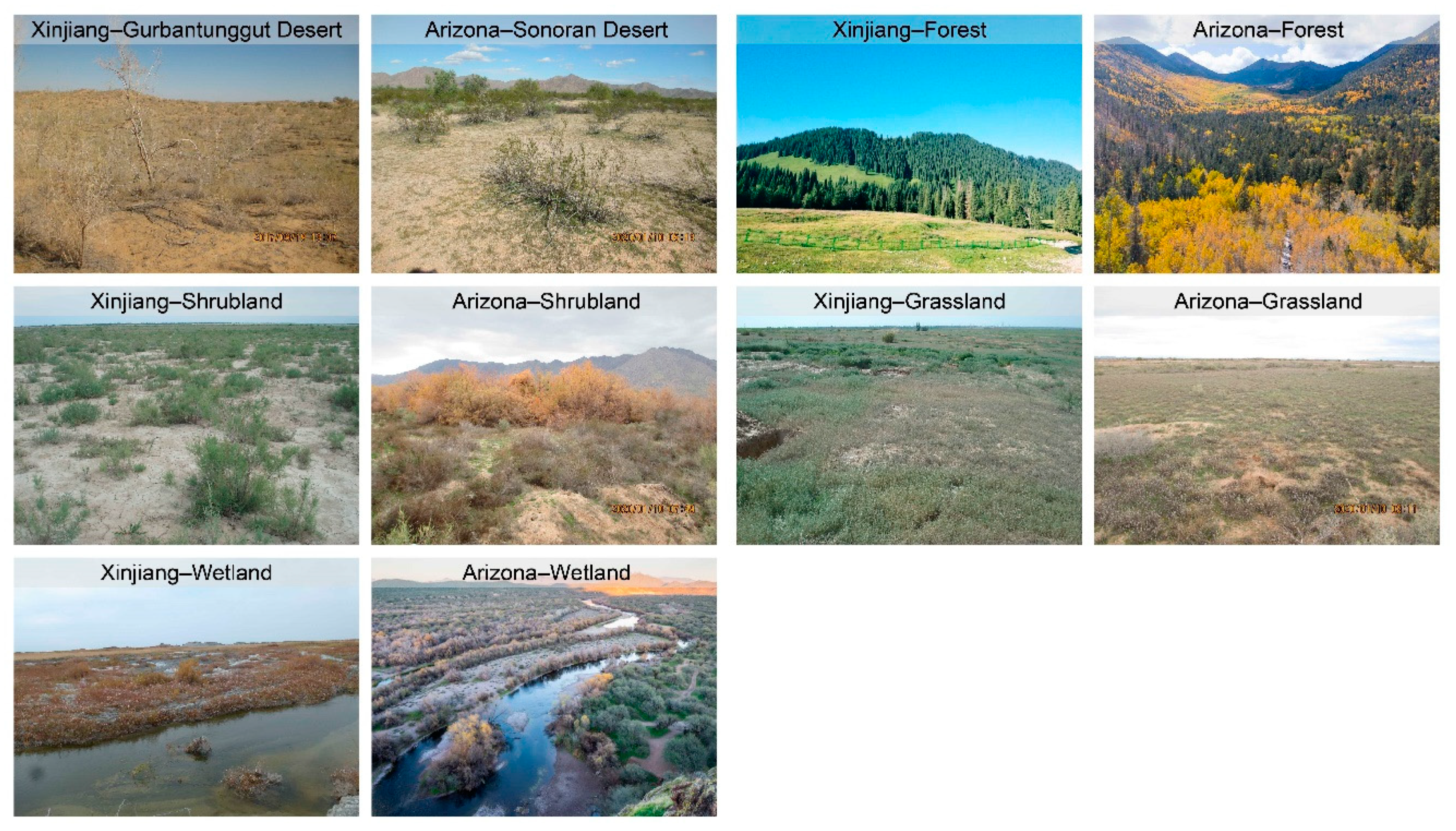
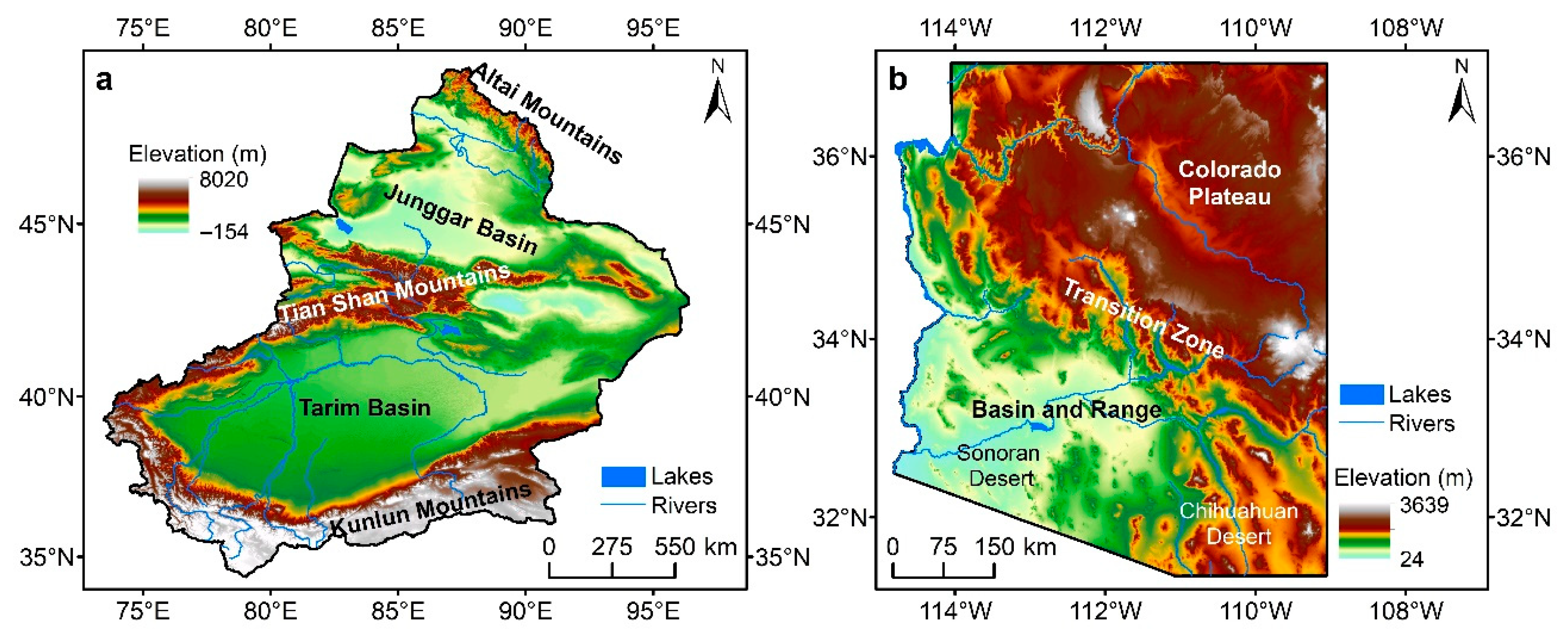

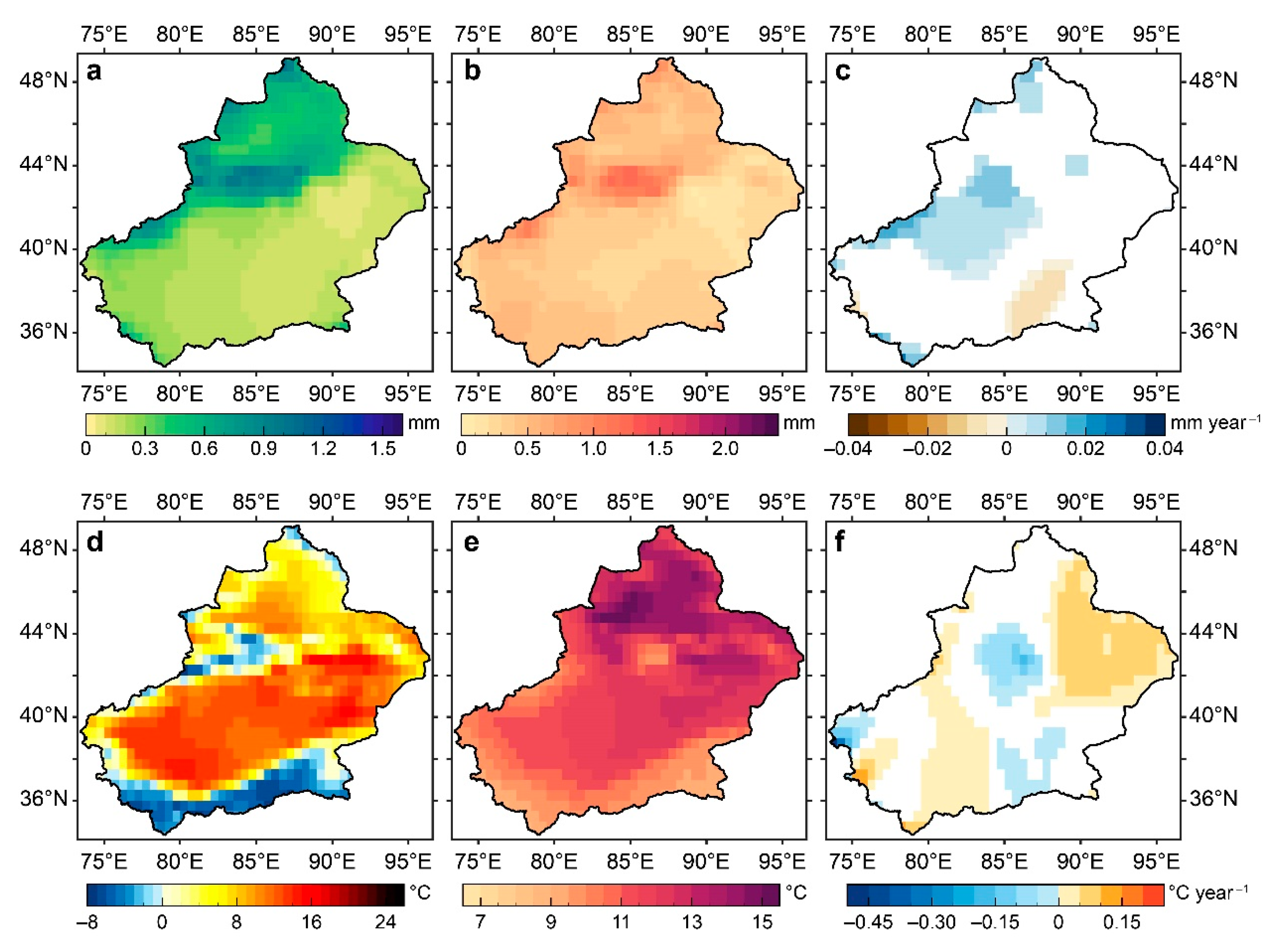
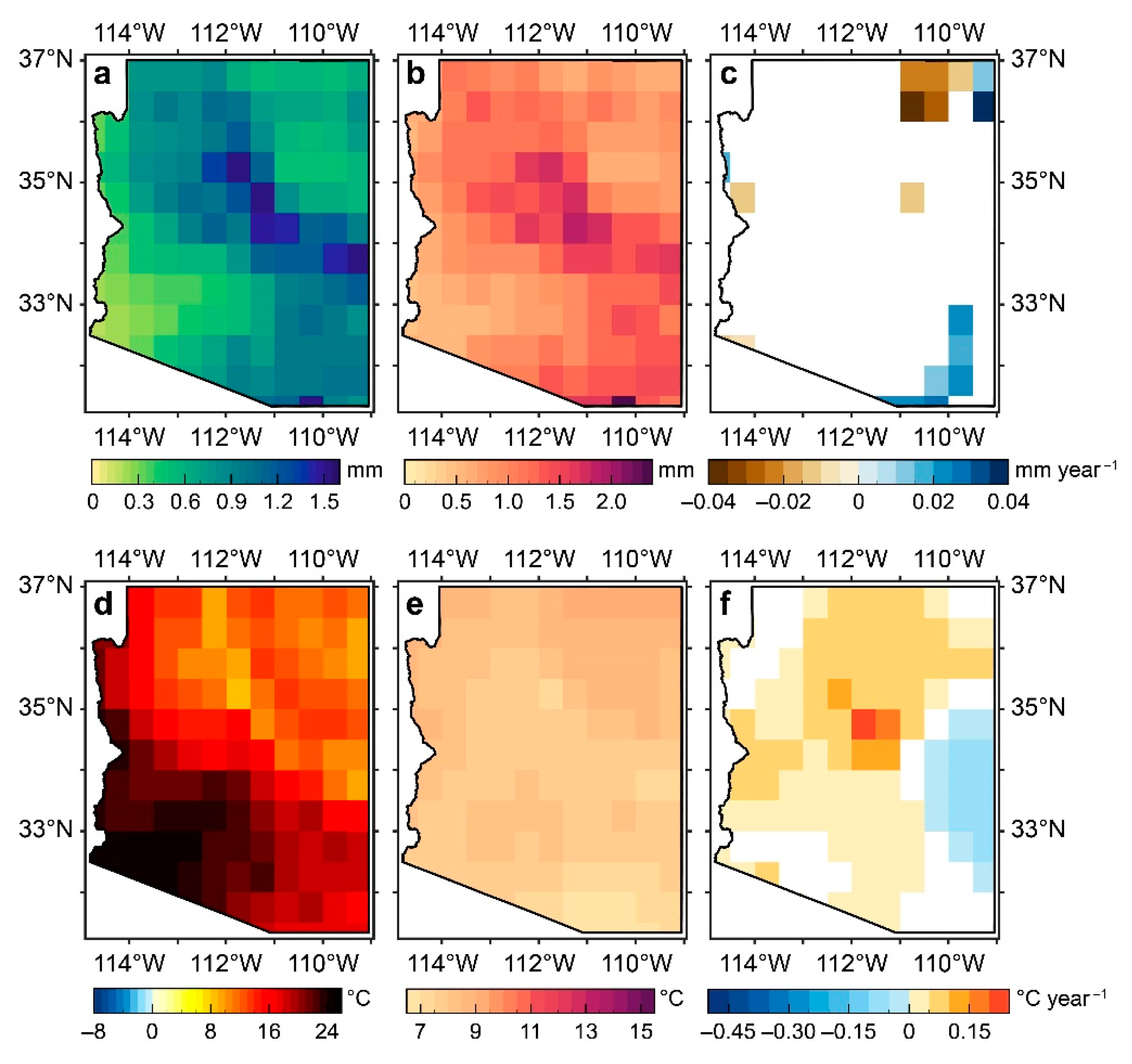
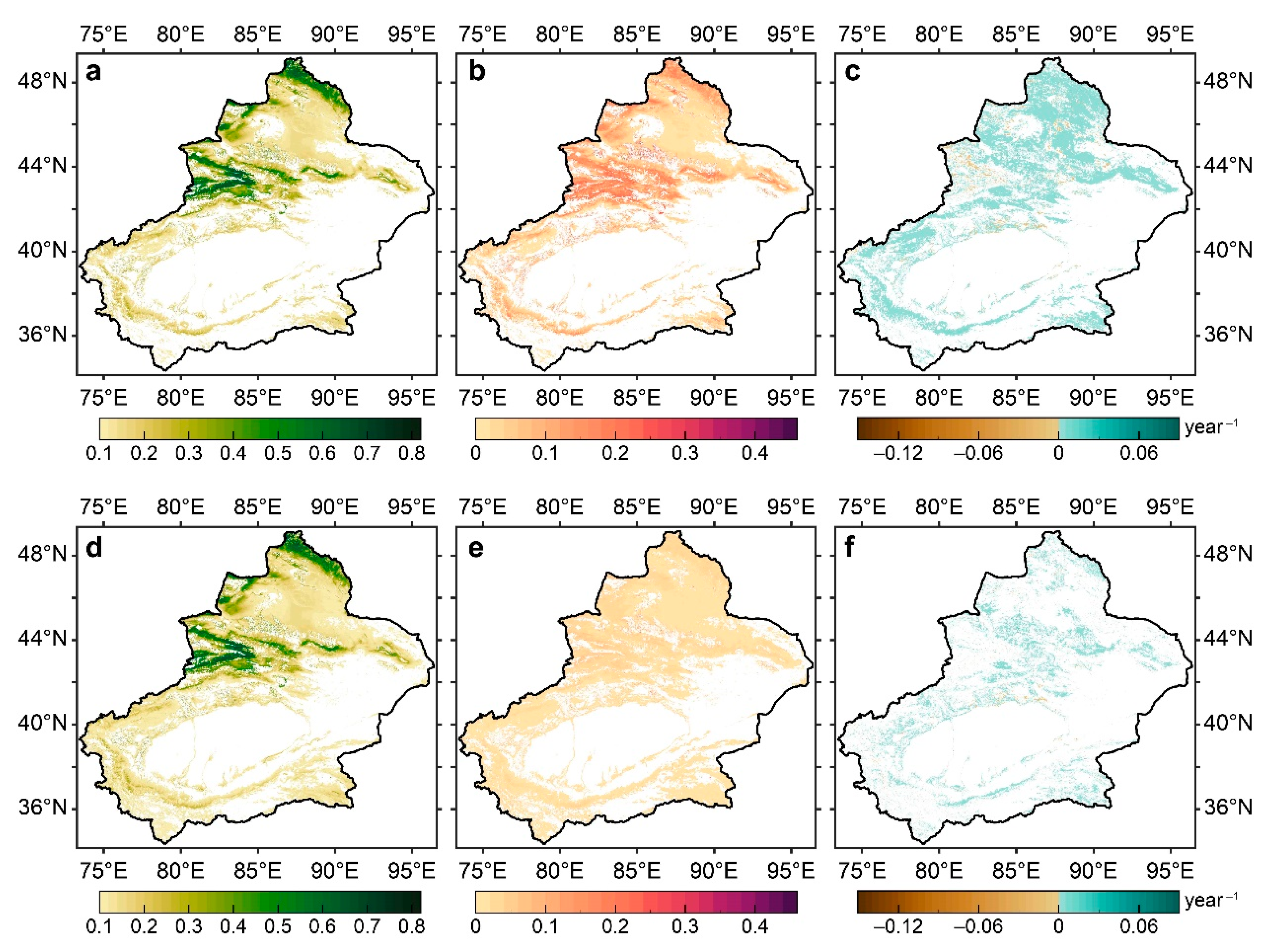
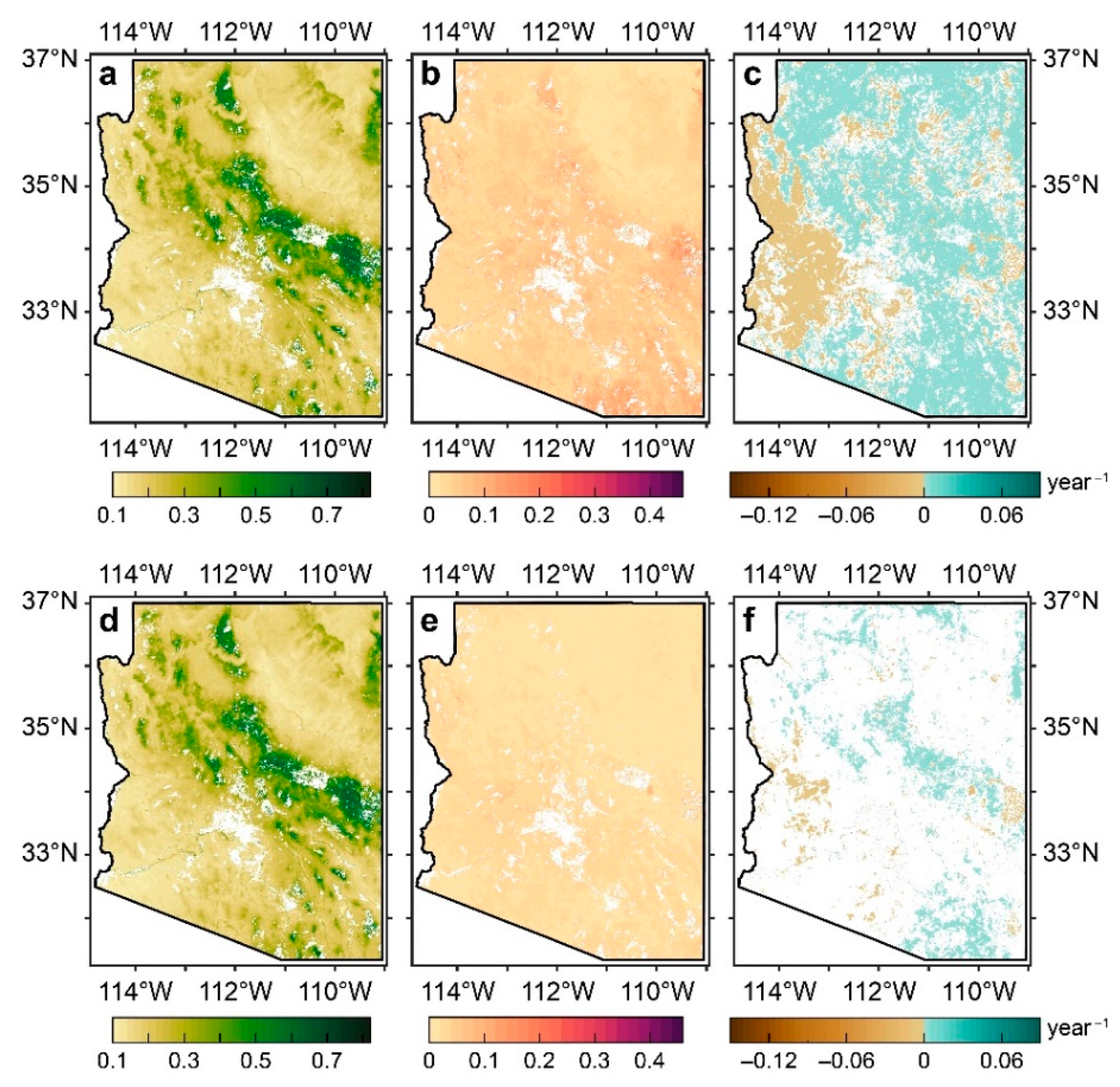
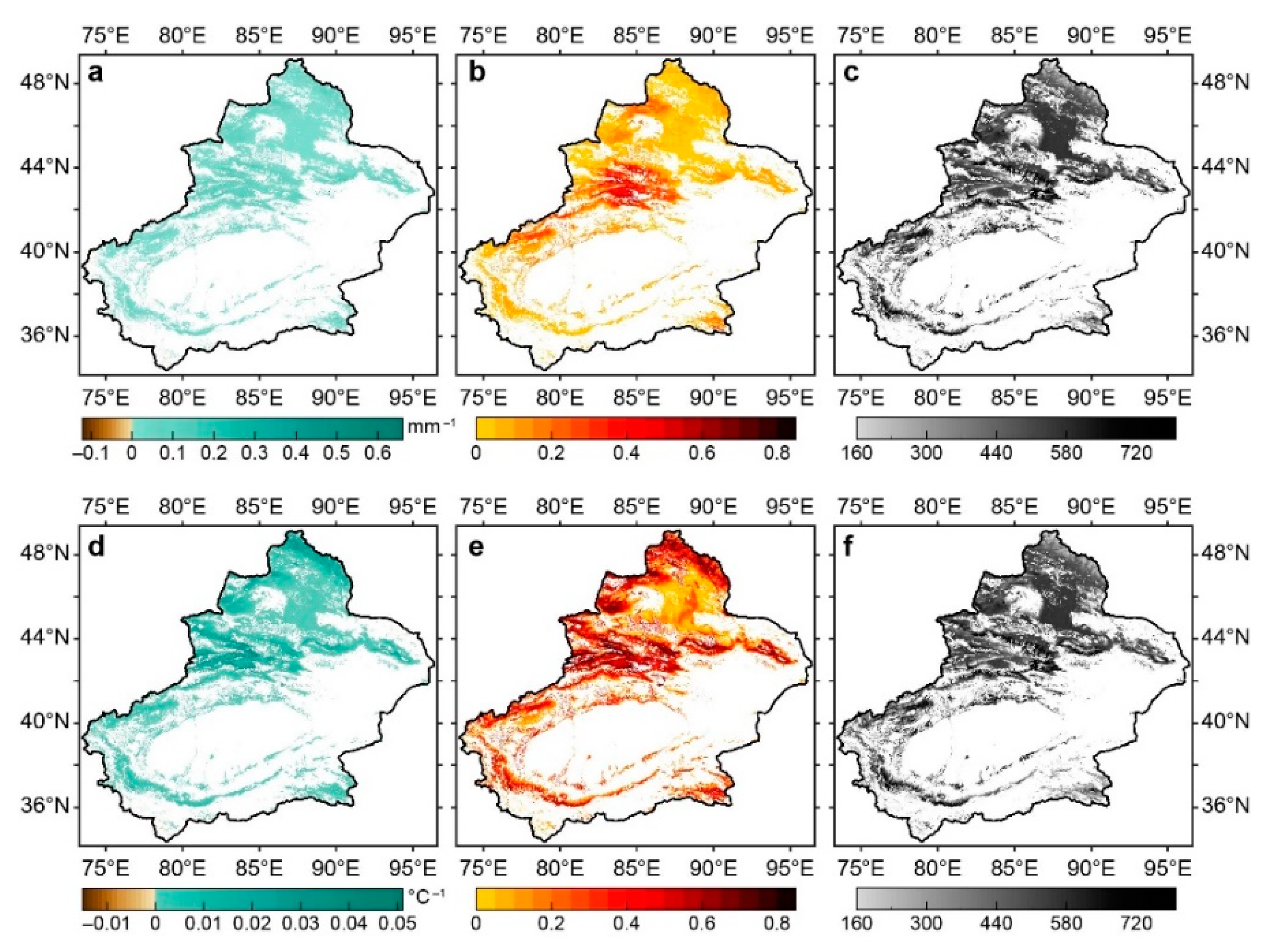
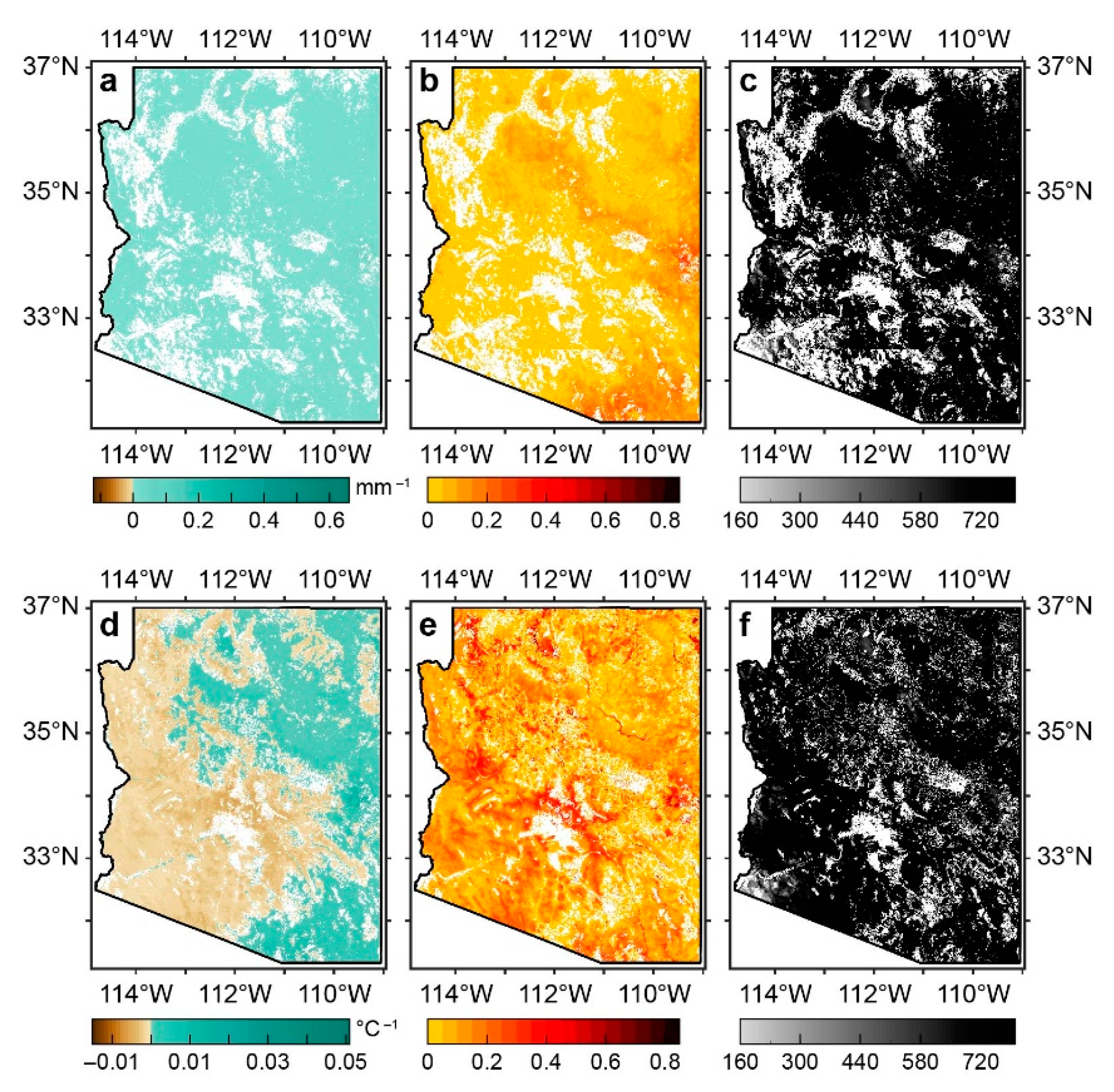

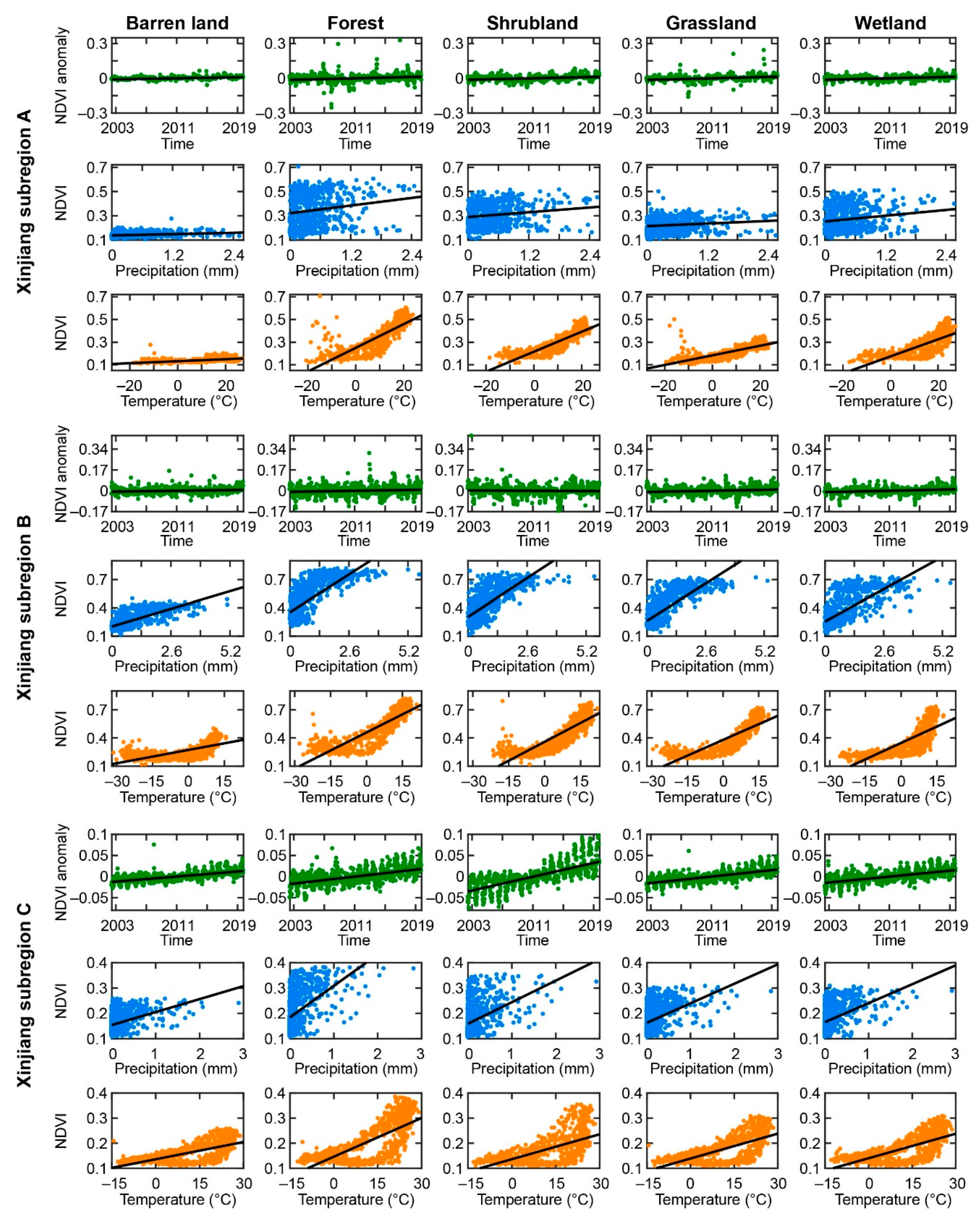

| Reclassification | CNLUCC | NLCD |
|---|---|---|
| Water | 41: river and canal 42: lake 43: reservoir and pond | 11: open water |
| Perennial ice/snow | 44: perennial ice/snow | 12: perennial ice/snow |
| Developed area | 51: urban land 52: rural settlement 53: other developed lands | 21: developed, open space 22: developed, low intensity 23: developed, medium intensity 24: developed, high intensity |
| Barren land (rock/sand/clay) | 61: sand 62: Gobi 63: saline-alkali land 65: barren land 66: rock and gravel 67: other unused lands (e.g., alpine desert and tundra) | 31: barren land (rock/sand/clay) |
| Forest | 21: dense forest 23: sparse forest 24: other forests | 41: deciduous forest 42: evergreen forest 43: mixed forest |
| Shrubland | 22: dwarf scrub and shrub | 51: dwarf scrub 52: shrub/scrub |
| Grassland (herbaceous) | 31: grassland, high coverage 32: grassland, medium coverage 33: grassland, low coverage | 71: grassland/herbaceous 72: sedge/herbaceous 73: lichens 74: moss |
| Cropland | 11: paddy field 12: dry field | 81: pasture/hay 82: cultivated crops |
| Wetland | 45: intertidal zone 46: shoal 64: swampland | 90: woody wetlands 95: emergent herbaceous wetlands |
| Subregions in Xinjiang | Subregions in Arizona | |||||
|---|---|---|---|---|---|---|
| Subregion | A | B | C | A | B | C |
| Barren land | 21,650 | 4906 | 22,159 | 71 | 10 | 174 |
| Forest | 1701 | 3316 | 354 | 2356 | 4745 | 303 |
| Shrubland | 530 | 344 | 1366 | 15,426 | 12,584 | 15,312 |
| Grassland | 10,505 | 24,985 | 6978 | 1906 | 699 | 1094 |
| Wetland | 466 | 1197 | 762 | 49 | 40 | 95 |
| Total (five land cover types) | 34,852 | 34,748 | 31,619 | 19,808 | 18,078 | 16,978 |
| Fraction of subregion (%) | 86.3 | 86.0 | 78.3 | 99.6 | 90.9 | 85.4 |
| Barren land | Forest | Shrubland | Grassland | Wetland | ||
|---|---|---|---|---|---|---|
| Xinjiang subregion A | ||||||
| Time-NDVI anomaly | Slope (year−1) | 1.13 × 10−3 | 1.54 × 10−3 | 1.50 × 10−3 | 1.64 × 10−3 | 1.51 × 10−3 |
| R2 | 0.17 | 0.04 | 0.09 | 0.09 | 0.13 | |
| p-value | <0.0001 | <0.0001 | <0.0001 | <0.0001 | <0.0001 | |
| Precipitation-NDVI | Slope (mm−1) | 0.0092 | 0.0524 | 0.0326 | 0.0177 | 0.0396 |
| R2 | 0.05 | 0.03 | 0.03 | 0.02 | 0.03 | |
| p-value | <0.0001 | <0.0001 | 0.0001 | 0.0003 | 0.0001 | |
| Temperature-NDVI | Slope (°C−1) | 0.0009 | 0.0104 | 0.0088 | 0.0042 | 0.0075 |
| R2 | 0.27 | 0.63 | 0.77 | 0.56 | 0.57 | |
| p-value | <0.0001 | <0.0001 | <0.0001 | <0.0001 | <0.0001 | |
| n | 625 | 619 | 598 | 626 | 606 | |
| Xinjiang subregion B | ||||||
| Time-NDVI anomaly | Slope (year−1) | 0.82 × 10−3 | 0.98 × 10−3 | −0.30 × 10−3 | 1.13 × 10−3 | 1.31 × 10−3 |
| R2 | 0.03 | 0.01 | 0.00 | 0.03 | 0.06 | |
| p-value | <0.0001 | 0.0006 | 0.4090 | <0.0001 | <0.0001 | |
| Precipitation-NDVI | Slope (mm−1) | 0.0720 | 0.1544 | 0.1584 | 0.1526 | 0.1320 |
| R2 | 0.57 | 0.57 | 0.51 | 0.62 | 0.55 | |
| p-value | <0.0001 | <0.0001 | <0.0001 | <0.0001 | <0.0001 | |
| Temperature-NDVI | Slope (°C−1) | 0.0047 | 0.0128 | 0.0134 | 0.0112 | 0.0116 |
| R2 | 0.44 | 0.76 | 0.72 | 0.75 | 0.60 | |
| p-value | <0.0001 | <0.0001 | <0.0001 | <0.0001 | <0.0001 | |
| n | 792 | 797 | 691 | 797 | 714 | |
| Xinjiang subregion C | ||||||
| Time-NDVI anomaly | Slope (year−1) | 1.49 × 10−3 | 2.07 × 10−3 | 4.09 × 10−3 | 1.91 × 10−3 | 1.75 × 10−3 |
| R2 | 0.41 | 0.31 | 0.49 | 0.45 | 0.37 | |
| p-value | <0.0001 | <0.0001 | <0.0001 | <0.0001 | <0.0001 | |
| Precipitation-NDVI | Slope (mm−1) | 0.0512 | 0.1242 | 0.0851 | 0.0770 | 0.0749 |
| R2 | 0.19 | 0.26 | 0.22 | 0.21 | 0.22 | |
| p-value | <0.0001 | <0.0001 | <0.0001 | <0.0001 | <0.0001 | |
| Temperature-NDVI | Slope (°C−1) | 0.0023 | 0.0052 | 0.0033 | 0.0033 | 0.0033 |
| R2 | 0.45 | 0.53 | 0.39 | 0.48 | 0.50 | |
| p-value | <0.0001 | <0.0001 | <0.0001 | <0.0001 | <0.0001 | |
| n | 797 | 794 | 795 | 797 | 791 | |
| Barren land | Forest | Shrubland | Grassland | Wetland | ||
|---|---|---|---|---|---|---|
| Arizona subregion A | ||||||
| Time-NDVI anomaly | Slope (year−1) | 0.31 × 10−3 | 0.57 × 10−3 | 0.32 × 10−3 | 0.37 × 10−3 | 0.15 × 10−3 |
| R2 | 0.03 | 0.01 | 0.01 | 0.01 | <0.01 | |
| p-value | <0.0001 | 0.0014 | 0.0031 | 0.0017 | 0.2078 | |
| Precipitation-NDVI | Slope (mm−1) | 0.0028 | 0.0080 | 0.0054 | 0.0055 | 0.0076 |
| R2 | 0.04 | 0.05 | 0.05 | 0.04 | 0.05 | |
| p-value | <0.0001 | <0.0001 | <0.0001 | <0.0001 | <0.0001 | |
| Temperature-NDVI | Slope (°C−1) | 0.0004 | 0.0003 | 0.0007 | 0.0008 | 0.0018 |
| R2 | 0.13 | 0.01 | 0.11 | 0.14 | 0.40 | |
| p-value | <0.0001 | 0.0275 | <0.0001 | <0.0001 | <0.0001 | |
| n | 795 | 795 | 796 | 796 | 796 | |
| Arizona subregion B | ||||||
| Time-NDVI anomaly | Slope (year−1) | 2.26 × 10−3 | 2.06 × 10−3 | 0.91 × 10−3 | 0.04 × 10−3 | 1.03 × 10−3 |
| R2 | 0.14 | 0.17 | 0.02 | <0.01 | 0.03 | |
| p-value | <0.0001 | <0.0001 | <0.0001 | 0.8827 | <0.0001 | |
| Precipitation-NDVI | Slope (mm−1) | 0.0041 | 0.0055 | 0.0049 | 0.0063 | 0.0043 |
| R2 | 0.02 | 0.04 | 0.04 | 0.03 | 0.02 | |
| p-value | <0.0001 | <0.0001 | <0.0001 | <0.0001 | <0.0001 | |
| Temperature-NDVI | Slope (°C−1) | 0.0013 | 0.0002 | -0.0005 | 0.0001 | 0.0025 |
| R2 | 0.07 | <0.01 | 0.01 | <0.01 | 0.21 | |
| p-value | <0.0001 | 0.3024 | 0.0010 | 0.5033 | <0.0001 | |
| n | 797 | 797 | 797 | 797 | 797 | |
| Arizona subregion C | ||||||
| Time-NDVI anomaly | Slope (year−1) | 0.88 × 10−3 | 4.62 × 10−3 | 0.90 × 10−3 | 0.23 × 10−3 | 1.78 × 10−3 |
| R2 | 0.09 | 0.41 | 0.03 | <0.01 | 0.07 | |
| p-value | <0.0001 | <0.0001 | <0.0001 | 0.2350 | <0.0001 | |
| Precipitation-NDVI | Slope (mm−1) | 0.0043 | 0.0126 | 0.0057 | 0.0064 | 0.0052 |
| R2 | 0.06 | 0.08 | 0.03 | 0.03 | 0.01 | |
| p-value | <0.0001 | <0.0001 | <0.0001 | <0.0001 | 0.0006 | |
| Temperature-NDVI | Slope (°C−1) | 0.0001 | 0.0014 | −0.0008 | −0.0007 | 0.0015 |
| R2 | <0.01 | 0.04 | 0.04 | 0.03 | 0.07 | |
| p-value | 0.2320 | <0.0001 | <0.0001 | <0.0001 | <0.0001 | |
| n | 797 | 797 | 797 | 797 | 797 | |
Publisher’s Note: MDPI stays neutral with regard to jurisdictional claims in published maps and institutional affiliations. |
© 2020 by the authors. Licensee MDPI, Basel, Switzerland. This article is an open access article distributed under the terms and conditions of the Creative Commons Attribution (CC BY) license (http://creativecommons.org/licenses/by/4.0/).
Share and Cite
Zhang, F.; Wang, C.; Wang, Z.-H. Response of Natural Vegetation to Climate in Dryland Ecosystems: A Comparative Study between Xinjiang and Arizona. Remote Sens. 2020, 12, 3567. https://doi.org/10.3390/rs12213567
Zhang F, Wang C, Wang Z-H. Response of Natural Vegetation to Climate in Dryland Ecosystems: A Comparative Study between Xinjiang and Arizona. Remote Sensing. 2020; 12(21):3567. https://doi.org/10.3390/rs12213567
Chicago/Turabian StyleZhang, Fang, Chenghao Wang, and Zhi-Hua Wang. 2020. "Response of Natural Vegetation to Climate in Dryland Ecosystems: A Comparative Study between Xinjiang and Arizona" Remote Sensing 12, no. 21: 3567. https://doi.org/10.3390/rs12213567
APA StyleZhang, F., Wang, C., & Wang, Z.-H. (2020). Response of Natural Vegetation to Climate in Dryland Ecosystems: A Comparative Study between Xinjiang and Arizona. Remote Sensing, 12(21), 3567. https://doi.org/10.3390/rs12213567







